A Meal At The Mill House and a Tour of a Historic Plantation
Maui Tropical Plantation is a magnificent way to see Hawaii and take home a memorable vision. Eat at a table at the farm, ride a little tram around brilliant green grounds, and look up to the mist-covered West Maui Mountain range. This place is 1800 acres of Hawaiian history that you won’t forget! Before you travel, read James Michner’s ‘Hawaii,’ his epic tale of how people migrated to these islands for centuries, traveling in tiny outriggers and wooden sailing ships in search of a better life. Now, here you are, following in their path, and you suddenly figure out how this charming property will help you understand why they came.

Come for the day, walk in the gardens, lounge in the grass, observe the huge 19th-century water wheels, then watch the duck families about their business, ride the zip lines, and take a tram tour. Come for dinner and shopping; come for the mountain views. There are plenty of ways to enjoy the historic Maui Tropical Plantation.
Changes Since Our Visit To See A Table At This Farm
Following the destructive Covid era, which damaged many travel-related businesses, there have been a few changes. The major one is a new restaurant vendor and an enhanced fresh market as a replacement for the former gift shopping space. I am highlighting those new features in the text below. A fact to keep in mind is that following a life-altering disruption in business, many tourism-oriented economies will make different decisions about what to offer us, visitors.
Once the Venitians saw clear water and fish in the Grand Canal, they limited how they let the rest of us in. Covid was a terrible disease, and future societies will remember it like the Spanish flu of the early 20th century. We can expect that Hawaiians will make similar decisions. I live in a winter resort community, and we have learned that a little respect goes a long way.
Getting There
Maui Tropical Plantation is a 30-minute drive from Lahaina via HI-30 E. It is about one-half that distance from the airport. You will need a rental car or driver, or you can join a tour that includes the Plantation. We stayed on Ka’anapali Beach, near Lahaina, and enjoyed the freedom of a rental car. We carried our snorkeling equipment and made multiple stops at beaches around the island. Some of the mountain roads are a thrill. I would call Lahaina to the Plantation an easy drive.
‘Snorkeling on Maui’ is our impression of how to get in a lot of snorkeling and still have time for everything else.
We put plenty of mileage on our rental car and visited much of this big island. Maui is the 17th largest island in the United States and the second biggest in the Hawaiian archipelago at 735 square miles. We traveled extensively but did not choose the famous ‘road to Hana.’ Adding another day or two and staying over would be our thought if we return. And we’d love to!
Here is what we did to understand the island and make decisions as to how to schedule our time. We mentally divided Maui into six regions with distinct features. When time is valuable, this plan might help; here is how we did it. ‘Discover Maui’s Six Distinct Regions-What to See and Do.’
Hawaiian History Standing at a New Crossroad-Right in Front of You
Maui Tropical Plantation is a historic Hawaiian Sugar Cane Plantation. Sugar and Pineapple crops created Hawaiian wealth, providing new economic opportunities after the end of the profitable Whaling era. (In fact, if you have ever visited Nantucket, off the coast of Massachusetts, you will see striking parallels.)
The plantations required broad immigration to the islands, and their output influenced the American Civil War, the California Gold Rush, and the establishment of Hawaii as an American State.
Hawaii Facing Change
This is what the residents of the Hawaiian islands are seeing today as their agriculture changes and adapts.
- In 1980 Hawaii had 14 sugar and four pineapple plantations encompassing 300,000 acres of land.
- By 2017 the area tilled dropped to below 5000 acres.
- Maui’s last sugar plantation and mill closed in 2016. There is one specialty pineapple grower left supporting a distillery and a winery. These are the famous “Maui Gold Pineapples,” small but sweet. They sell them at the airport with an agricultural permit for export. They make a popular and unique gift to take home.
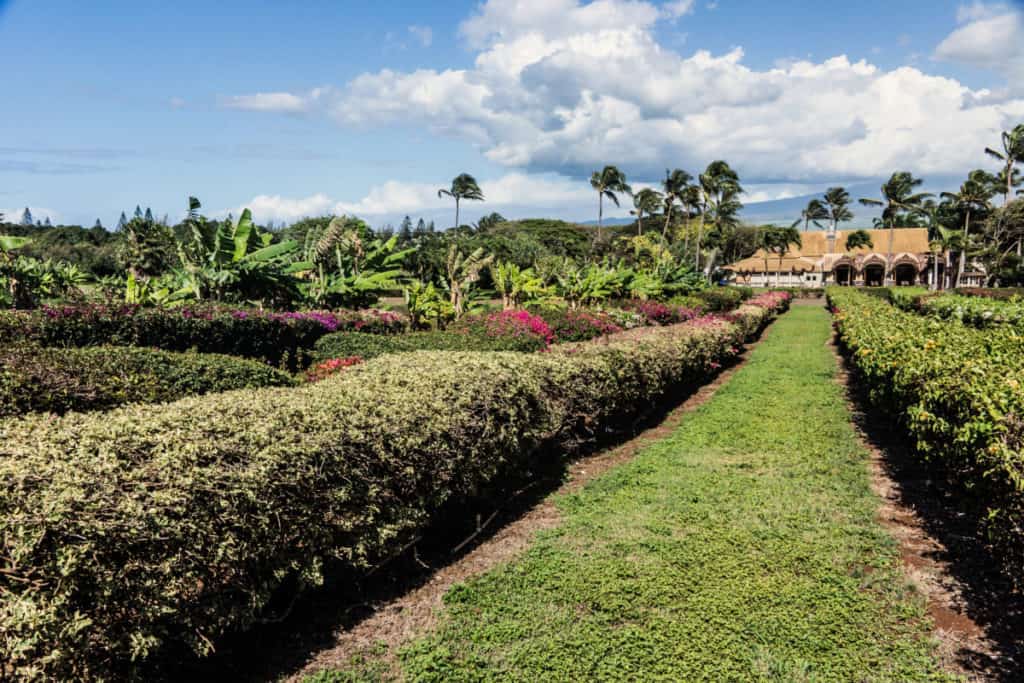
Hawaii’s Agricultural Future
Hawaii has enormous opportunities as well as challenges not faced elsewhere.
- It has some of the highest land costs in the USA.
- Farmworkers are in short supply, and there is tough competition from places with cheaper labor.
- Food Costs: Hawaii spends over $3 billion to import over 90% of its food. Despite extensive space and fertile land, egg and food costs are as high as anywhere in the USA.
- It has the highest electric costs in the USA.
- Any natural disaster could impede the importation of goods.
This Plantation is a Sign of Change
Alternative agriculture must be developed. The transition from a focus on imported food is not only less risky, but the health and flavor benefits will be enormous. There is, right now, more water available for alternative forms of agriculture because sugar was a big water user. Throughout the islands, small-scale experiments of all kinds are ongoing.
For example, feed grain for cattle must be imported, resulting in cattle being sent to off-island feedlots. Superior pasturage is available, allowing animals to lead a natural life. If a market for grass-fed meat can continue to develop, this can be important to the economy, jobs, and us tourists.
Energy costs need to come down, and agricultural innovations will be critical.
Maui Tropical Plantation and Food Innovation
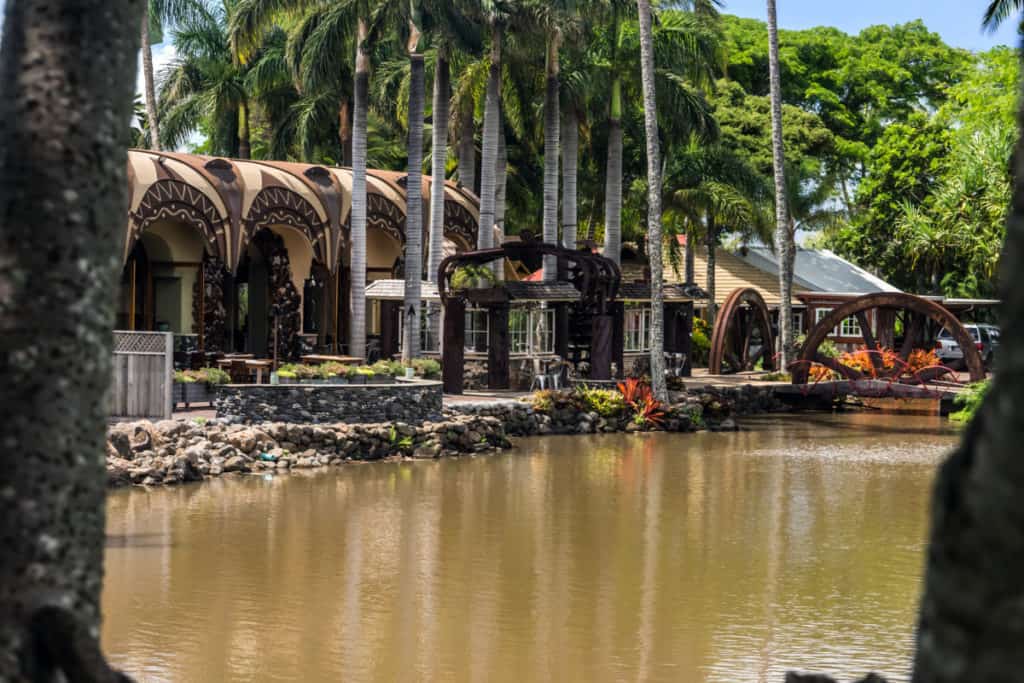
This place feels as if you are present in the early days of something special. It’s a transition in Hawaiian agriculture and the development of a food culture that is worth coming for. Our first trip to Hawaii was to a beautiful resort with an enormous variety of restaurants, but the food offered was nothing like what is available today.
As visitors, we found it fascinating to be at the epicenter of a new food and farming culture.
What To See At Maui Tropical Plantation
- The plantation encompasses 1800 acres, deployed in several ways. Views are everywhere you go, but the tram tour is the most informative. In about 40 minutes (sitting down), you get a good overview.
- Cattle grazing; looking up beyond the duck pond, we see Longhorns, the first of which were gifts to King Kamehameha in the 1790s. There are also Black Angus and others belonging to Beef and Blooms, an early organic cattle company.
- Kumu Farm at the Country Market -organic vegetables and fruits within the plantation. If you stay in a condo with a kitchen, you can eat well from their onsite store. You will also eat their produce in the Restaurant. If you visit their website, you will see online ordering opportunities.
- We visited a large giftshop in its own building at the entrance; today, it is called The Country Market and houses the fresh market, coffee, and cafe.
- Maui ‘Oma Coffee-coffee beans are grown on-site or elsewhere in Maui and roasted where you buy them. You can bring home the beans or grind them on-site. It shares the Country Market.
- Kumu Cafe, also at The Country Market, is a place for a quick breakfast or snack.
- Zipline Tours- this is not agriculture, but it provides jobs and entertainment using airspace above the plants.
- At the time of our visit, farmers, fisheries, and food producers throughout the island sold to retail outlets and the Restaurant.
- The Mill House Restaurant- not only are they serving true “Hawaiian Regional Cuisine” but in a setting that is one of the nation’s rare “table at the farm” locations.
- Above is what I wrote, and it was a lovely experience in all ways. The Mill House Restaurant has been replaced by Cafe O’lei. I have given you a link to its web page and some Trip Advisor reviews.
- Malama Studio features local artisans doing work that represents traditional Maui handwork. It is located near to the Plantation restaurant.
- Several special event venues.
Tour the Plantation -Fly on a Zip Line-Shop
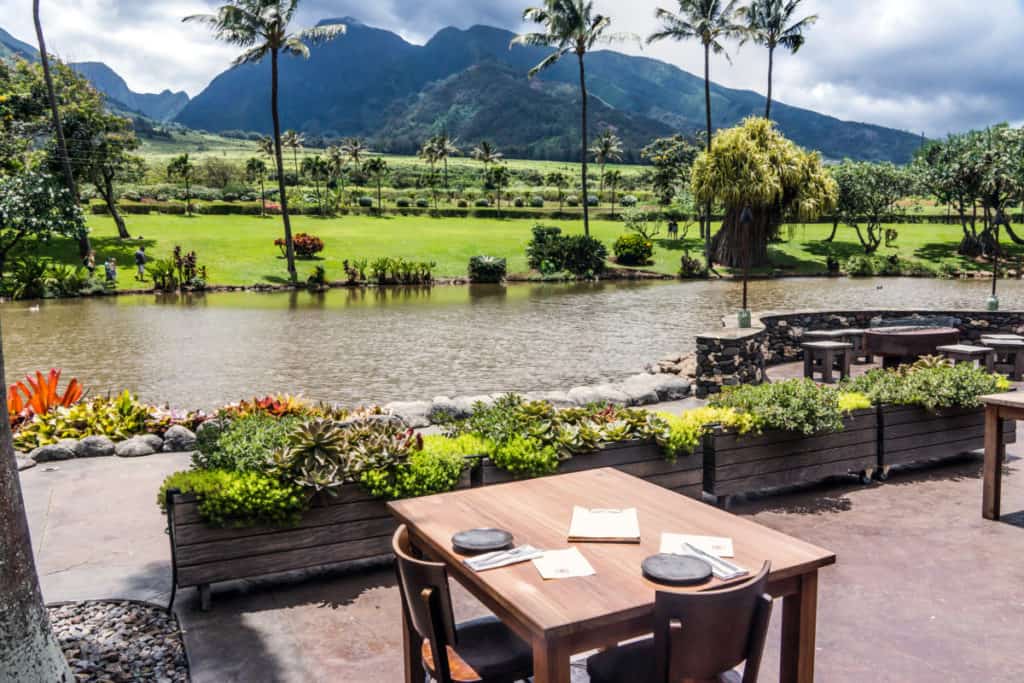
Wailuku, the local town, was once a lively tropical village accommodating the sugar cane workers. They are long gone now, but descendants are involved in new ventures, and I read that there are redevelopment plans.
Shopping
In the midst of this green plantation overlooked by the West Maui mountains, they have recreated the village atmosphere with shopping in colorful wooden buildings. You can buy souvenirs, local coffees and plan a private event for 2-6,000 of your friends.
You will find Malama Studio in this area. According to the owner, Isabelle Graf, the store carries the handiwork of 25 local artists and small business owners. Look for paintings, organic skincare products from Hawaiian sources, and tropical syrups you can take home for cocktail hours that will take you back to the islands. Check the website when you go for opening hours.
Free Admission-A Chance To Meet The Neighbors
Admission to the public areas is free whether or not you are dining. We met local neighbors out for their daily walk. One, a retired California school teacher, said, ” I love it here; I come for my walk every morning; I see the animals and get some exercise.” Together we watched this little bird perched on the mirror of a motorcycle, infuriated by the sassy bird in the mirror.
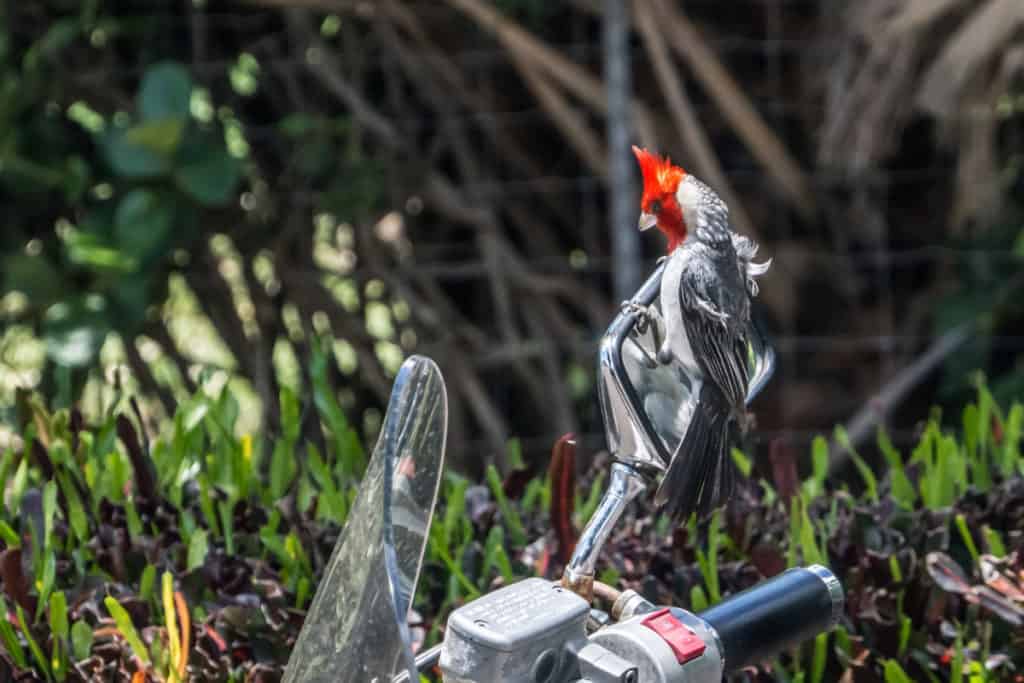
The Zip Line
There are five ziplines ranging from 300 to 900 feet. You can sail over the plantation and see bi-coastal ocean views. Some ziplines are designed to accommodate children. You also provide free entertainment for the diners at lunch overlooking the ponds. We toasted each one as they blew by.
The Plantation Tour-Via Tram

This is a tour of the plantation and its gardens with good views of the sugar mill and mountains. You ride in a Disney Style tram with a guide who tells about the crops and demonstrates opening a coconut. Now I know how- but I’m not likely to do it.
There are signs explaining weather forecasting using coconut trees. ” If the coconut on the tree is waiving-it’s windy. If the coconut is wet…” Country humor! A link to the website for further information is at the end of this piece.
The Mill House Restaurant
This was such a rare opportunity that I am leaving my review in place so that you can appreciate the eating opportunities Maui has to offer. Everybody loves the idea and taste of “Farm to Table” Dining. The whole concept is attractive; eat fresh, clean food at its peak of ripeness. Seasonal food, no middlemen, no waste.
It is harder than it looks! It is more complicated for the restaurants; they deal with lots of suppliers. A Florida wholesaler who specializes in aggregating fresh farm produce to very local restaurants can reduce 300 overall suppliers by about 60! Regulation is also tough.
A Table at the Farm
There are not many places like this. The table is on the farm! The cooks claim that if they run short of produce, they just go outside. At the end of this article is a link to another such place in Florida and a good newspaper series on the subject, including its pitfalls.
Hawaiian Regional Cuisine incorporates local products and the food traditions of many immigrant groups. Workers on these plantations came from China, Japan, Korea, and Portugal; it goes on.
There are no anticipated menu items. At Mama’s Fish House on Maui, you can expect certain fish dishes, and they are fresh because their suppliers are well established.
Here you are going to eat exactly what the farmer produces today. The Mixologist uses the same process. The drinks change on the fly. If kumquats are in season, that’s the citrus you will see.
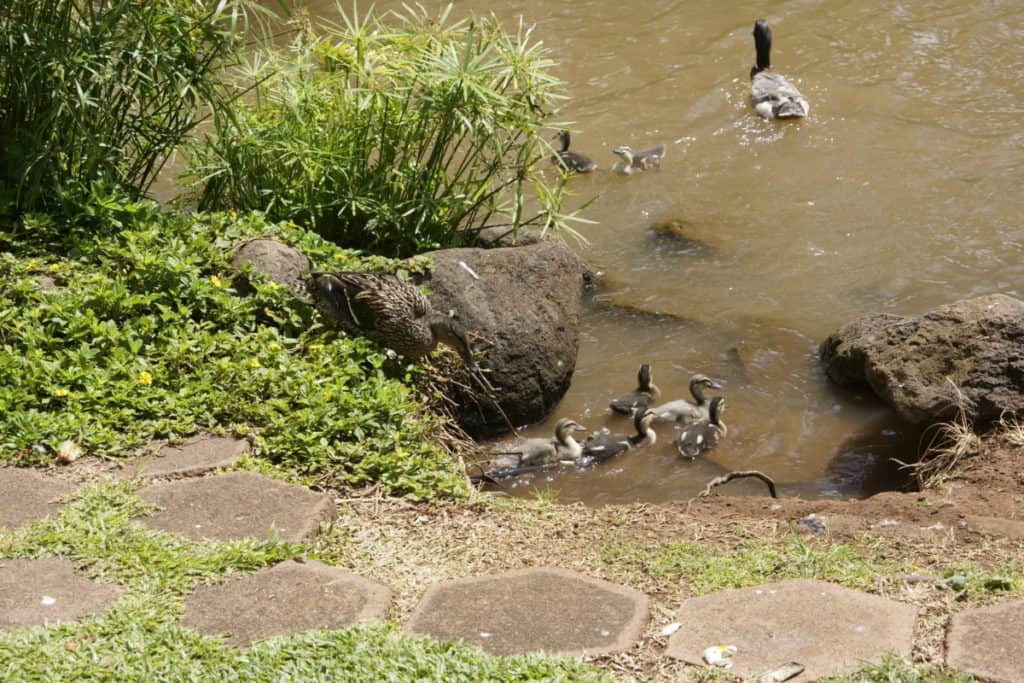
It is an open-air, tile-floored, rustic space with tables inside and on a patio, all with views of mountains and a duck pond. Lunchtime entertainment included a mother duck who could not quite get her entire flock of 8 out of the pond. She climbed down from the rock and pushed them up!
My Thoughts on Eating on Maui
I live in a coastal resort town on the edge of the Gulf of Mexico; in that way, we have some similarities to Hawaii; in addition, we live close to the major winter agricultural area of the East Coast. If you can eat it fresh in winter, we grew it.
If you are like us and appreciate good food, choose wisely on your trip to Maui. The large island is blessed with many open acres of rich, volcanic soil perfect for farm-fresh produce of all kinds, and the Hawaiians are creatively using them.
Choose restaurants that buy directly from farms and fishermen. In a good Maui restaurant, while seated at your meal, it is not unusual to see fishermen carry a whole fresh fish between the tables to the kitchen. That is the way to eat!
Also, select food uniquely suited to Maui eating. For example, I do not know Cafe O’lei, but I see on their website that they buy from local farmers, and on their menu, they offer the Maui version of French Onion soup. On a tropical vacation, you might not think to order French Onion Soup. You would be missing something nice!
Good Food Selections
Think beets, Maui sweet onions, lovely tomatoes, local meat, and fish. What is the deal with Maui sweet onions? Maui’s volcanic soil is low in sulfur, making the onions sweet, as are our southern Vidalia onions. They are worth eating whenever you can get them.
If you buy some, they have more water than most onions. This means they may not last as long as some others. They should last for one month in the refrigerator.
The Chef’s Table
There was, at the time of our visit, an outdoor, tented chef’s table offering food on Saturday nights at the peak of seasonal flavor. We did not know about it in time to reserve a place. It is my assumption that it is not available now, but if you can find such a meal on Maui, with its abundance of quality local producers, you might try it out.
Some useful Information
Location: 1670 Honoapl’ilani Highway, Waikapu HI 96793
Hours: Plantation, 8 am-9 pm. Plantation Store, 9 am-6 pm. Mill House Restaurant, 11 am- 9 pm.
Costs: Tram Tour, $24.00 adults, $12.00 Children 3-12.
Maui Tropical Plantationhttps://mauitropicalplantation.com/
Mama’s Fish House Restaurant, Maui -this is an opportunity for a special restaurant meal and one of those unusual times when a great view and a great meal can be had in one place! You will find it on the North Shore.
Pacific O’s on the Beach Fresh fish and their own farm produce. See the photos and menu.
This is a “Table at the Farm” Dining opportunity in SW Florida
This is a series of articles discussing improvements needed in Farm to Table Restaurant Dining: Farm to Fable, Tampa Bay Times
Update: New Sunscreen Regulations
Update: Using Sunscreen in Hawaii, Starting January 1. 2021
Effective January 1. 2021 Hawaii will no longer permit the sale of sunscreens containing these ingredients.
- Oxybenzone
- Octinoxate
This is a decision made by the state to avoid the continued damage to coral reefs.
The next scheduled change to take place will be in January 1, 2023 when those formulations will not be allowed to be used at all on Hawaii.
Hawaii is not the only jurisdiction to enact such regulations to protect the reefs and marine life.
Aruba, The Marshall Islands, US Virgin Islands, Palau and the city of Key West Fl have taken similar actions.
Currently the favored sunscreen ingredients are the following:
- Zinc Oxide
- Titanium Dioxide
This appears to be based on the FDA ruling that only these two ingredients (which create physical barriers between skin and sun) belong in its Category 1 “generally regarded as safe.”
Why is this an issue? Here is a story I read online. A guy said that he loved to eat fish at a certain restaurant in the Bahamas because of the coconut flavoring in the fish. Someone asked the chef, “What do you flavor the fish with?”
He said, “ Oh, I only use salt!”‘
Here is more information on the legal changes and the other locations already involved,
